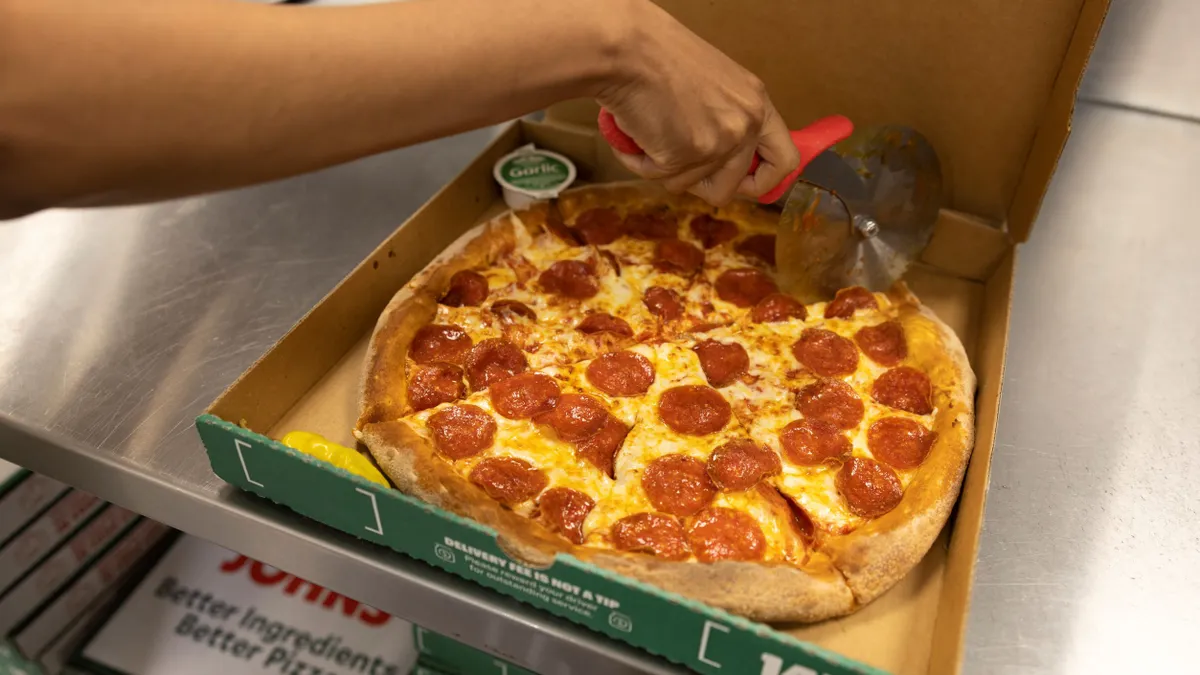Despite the buzz engulfing AI-powered tech over the past year, artificial intelligence is just a slice of the whole pizza powering Papa Johns.
“I believe a great digital practice and programming team should be intensely focused on the problem before the solution and intensely focused on the customer before the technology,” Justin Falciola, SVP and chief technology and insights officer at Papa Johns, told CIO Dive.
When Falciola joined the pizza company’s team in 2016, Papa Johns' operations were about 50% digital. Today, that number is somewhere between 75% and 95%.
Falciola is responsible for data science, business analytics, information security, IT operations and contact centers. The majority of the company’s technology spend is still domestic, but Falciola said more and more of his day is spent working with the global team to ensure they have the right technology needed to be successful.
“One of the questions I like to ask is, 'Where do we feel we need to be best in class versus where we feel it’s okay to be less transformative and more just incremental, iterative improvement?’” Falciola said. “And if you don’t like to answer that question, you’re going to end up wasting a lot of money, you’ll bust a lot of eggs open, you’ll leave a big trail in your wake and won’t accomplish too much.”

For AI and ML technology, Papa Johns focuses its efforts on areas where it can improve efficiency while monitoring and tuning systems when the stakes are high, such as when credit card numbers or customer information is involved.
Machine learning algorithms support customer retention by predicting orders and targeted marketing campaigns. The company uses AI to help better understand price elasticity and quote time algorithms, an especially hard metric to get right, according to Falciola.
“There’s a lot of dynamic stuff and we have very compressed parts, so the algorithms have proven to be challenging to tune,” Falciola said. Now that they’re tuned, Papa Johns feels like it couldn’t live without them.
Finding value
Businesses across industries are looking to AI for a slew of reasons, whether it’s to cut costs, become more efficient or improve customer experience. But without the right guardrails in place, setting the tech loose within an organization can have the opposite effect.
Generative AI and conversational AI are expected to deliver ROI for most organizations within the next two years, according to Forrester’s Top 10 Emerging Technologies for 2023 report published in July.
But explainable AI, the techniques and software capabilities that ensure businesses understand how and why AI systems generate outputs, won’t bring organizations an ROI until two to five years, according to the report.
“We’re going to see some use cases that are going to create real, measurable benefits within the next few years,” Brian Hopkins, VP, emerging tech portfolio at Forrester, said. “That doesn’t mean there aren’t risks — in fact, there are a lot of risks — and that we think is going to test firms’ ability to make good risk and reward decisions.”
One of the drawbacks with AI is that algorithms don’t always work how they’re intended or expected to perform. And that’s part of the reason Falciola remains cautiously optimistic when implementing and experimenting with the technology at Papa Johns.
“We use AI to do a lot of anomaly detection on various e-commerce channels, and that’s huge because we don’t want to lose a single word [or] a single bad customer experience,” Falciola said. “So we intervene a lot.”
Sometimes intervention looks like reaching out to the customer or the store. Other times the team can tune the system in real-time or tune it for the next release, but some type of intervention happens on a daily basis, according to Falciola.
Experimenting with AI
While AI is just a piece of the company’s larger digital transformation efforts, Papa Johns has a laundry list of technology experiments.
The company is experimenting with using AI for labor forecasting and scheduling, as well as testing conversational AI to attract talent. Papa Johns is also tuning a dispatching system to determine the best available driver whether it’s someone at the store, a third-party driver or someone about to return from a delivery.
The dispatching system will predict the arrival time of customers and drivers and is currently in use as it’s being tuned.
“We have not done a lot yet with generative AI like everyone else and that’s really where a lot of the hype is,” Falciola said. “But we are starting to look at it like how could generative AI help us in terms of software development, being creative and training team members.”
Falciola said tech leaders in a similar spot should remember they don’t have to reinvent the wheel even with disruptive technology.
“Technology folks are first and foremost business folks, and so don’t forget the things that made you successful already, and typically that’s taking an analytical approach to things, asking great questions and having really great partnerships and relationships with business teams,” Falciola said.




















